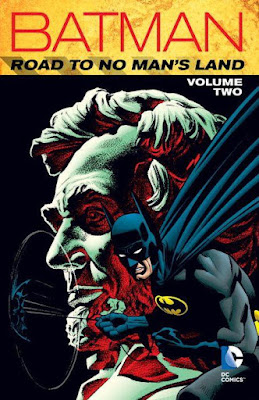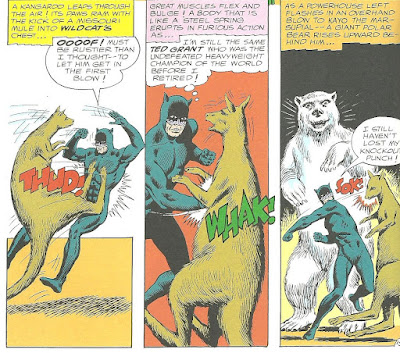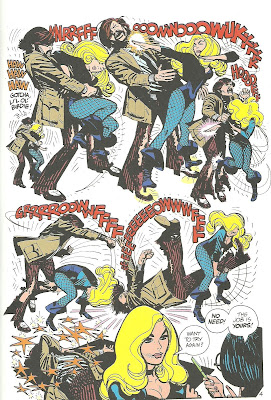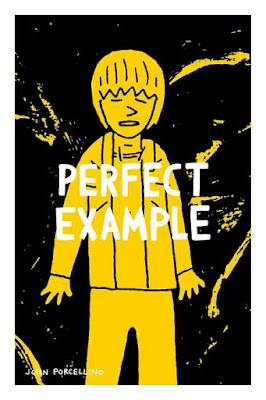Batman: Cataclysm (DC Comics; 2015) This 464-page, $29.99 trade paperback collects all of the "Cataclysm"-branded Batman family comics DC published in the spring of 1998, telling the story of a massive earthquake striking Gotham City. These include three issues of Detective Comics, two a piece of Batman, Shadow of The Bat, Robin, Nightwing and Catwoman, a single issue of Azrael, an issue of the quarterly anthology comic Batman Chronicles and a trio of one-shot specials. These specials focused on book-less characters one might reasonably wonder about in the sorts of event chronicled here: Batman: Blackgate—Isle of Man, detailing the fallout of the earthquake on the Blackgate prison population; Batman: Huntress/Spoiler—Blunt Trauma #1, featuring the two female vigilantes tackling a group of Blackgate escapees in ruined mall; and Batman: Arkham Asylum—Tales of Madness, showing how The Joker, Riddler, Scarecrow and a handful of other inmates passed the time during a quake-caused blackout.
The storyline is written relay-style, with the writer of each respective monthly handing the baton off to the next, making for a style of storytelling that would have obviously been familiar to readers of DC's Superman during its "triangle" years, or previous Batman events like "Knightfall," "Contagion" and "Legacy."
The result is a stack of comics—or, collected like this, a graphic novel, I suppose—that honestly reads like a novel, demonstrating the skills and teamwork of a particularly strong set of writers, then edited by Denny O'Neil (who also scripted the Azrael chapter), Archie Goodwin and Scott Peterson.
The quake strikes in the second chapter of the collection, following a neat done-in-one prelude in which writer Chuck Dixon contrasts a loudmouth inmate's story of an encounter with the Batman, drawn by Flint Henry, with what really happened, as drawn by Jim Aparo, which makes great use of the artists' contrasting styles.
From there, we see Batman and his extended cast of sidekicks, lieutenants, police officers and villains grappling with the apocalyptic scenario of a 7.5 on the Richter scale earthquake striking the center of a major metropolitan city, a nightmare unlike any of those that Batman and his fellow crimefighters usually struggle with, as there doesn't seem to be any villain to catch and punish, no fiendish plot to disrupt. It's just a natural disaster, albeit one on such a scale that it is hard for anyone to imagine Gotham City surviving it—which it only barely does, of course, as this eventually leads to the much longer saga of "No Man's Land," during which the federal government essentially gives up on Gotham City and closes it down.
After the first few chapters in which various characters react to the disaster, we watch as our heroes Nightwing, Robin, Oracle Barbara Gordon and Batman try to find one another and make sure they are all okay while dealing with the fallout of the disaster right in front of them as they move. Eventually they all reunite, just in time to find a shadowy figure calling himself "The Quakemaster" who claims responsibility, and threatens to follow-up with an even bigger quake that will finish the city off.
It flows quite nicely from chapter to chapter, moving, as I said, much like a novel, with only a few exceptions. The second issue of Catwoman, in which the feline fatale goes up against Poison Ivy, and Tales of Madness both interrupt the Quakemaster plot, and thus the momentum of the book, with unrelated plotlines.
Dixon writes the lion's share of the collection, as he was the regular writer of Detective, Robin and Nightwing (he also wrote the Huntress/Spoiler one-shot). He's joined by Alan Grant (Shadow of The Bat, Tales of Madness), Doug Moench (Batman, Isle of Man), Devin Grayson (Catwoman, a Chronicles short story), O'Neil (the aforementioned Azrael) and a handful of others who contributed short stories to Chronicles.
The artwork is, predictably, all over the place, but includes artists familiar from the era, including Aparo, Graham Nolan, Klaus Janson (sometimes inking Nolan, sometimes handling pencils himself), Scott McDaniel, Jim Balent, Staz Johnson and then-Shadow of the Bat artist Mark Buckingham, whose brief time with the Batman books I'd all but forgotten (I obviously dug his work though, as his Batman shared a lot in common with Kelley Jones', and he gave his Batman an extremely big, billowing cape that trailed behind him like an angry black cloud). Other contributors include the great Eduardo Barretto, who penciled the Blunt Trauma with inker Bill Sienkiewicz; Dave Talyor, who drew Tales of Madness with its ever-shifting styles (as it's a sort of Canterbury Tales of inmates in a storytelling contest for the rights to kill a captured guard, and each story gets drawn in its own style); and short stories from Rick Burchett, Chris Renaud, Alex Maleev and Marcos Martin.
I had only read a handful of these comics when they were originally released—mostly the Alan Grant-written chapters—so it was great fun to revisit this particular era of Gotham City history, especially given how well the book ended up hanging together as a single story with a beginning, middle and end, the few wanderings aside. Doing so definitely made me interested in re-reading what followed in a similar format, if I could get them.
Speaking of which...
Batman: Road to No Man's Land Vol. 1 (DC; 2015) This 280-page, $29.99 book picks up right where the above Cataclysm leaves off, collecting 1998 issues of the three Batman books (Batman, Detective Comics and Shadow of the Bat), plus one issue apiece of Robin and the quarterly anthology The Batman Chronicles. The individual issues were all branded "Aftershock" on the covers, and they continue Batman and company's grappling with the emerging status quo of an earthquake-ravaged Gotham City, here including mass casualties, an exodus of displaced people, corporate divestment and a handful of prison escapees on the loose.
Chuck Dixon, Doug Moench and Alan Grant do the majority of the writing, with a few shorter contributions from the Chronicles issue by Lisa Klink, Bruce Canwell and Greg Rucka, the latter contributing an illustrated prose piece.
The artwork is more varied, with Mark Buckingham and Jim Aparo among those contributing the most pages. Of particular interest are a couple of contributions by Norm Breyfogle, who pencils a Batman-free back-up in Shadow of The Bat #75, where he's inked by Buckingham, and Batman #556, where he's inked by Joe Rubenstein; Vince Giarrano doing lay-outs for finisher Sal Buscema, as interesting an art-team as one could hope for; Bob Hall, who pencils Batman #559 with inker Buscema; and Shadow of The Bat cover artist Brian Stelfreeze drawing a done-in-one Joker story written by Dixon.
While Cataclysm read like a novel, the writers more-or-less handling the event relay style, this first volume of Road To No Man's Land reads like more of an anthology, with shorter, often single-issue-long stories. It is now the status quo and the setting of post-quake Gotham that binds them al together.
I was particularly interested in a pair of stories which feature appearances from relatively minor characters I had written about here recently. The Giarrano/Buscema collaboration comes on the Moench-written "Ballistic's Evidence," featuring the last appearance of "New Blood" character Ballistic, here working as a sort of mercenary who always does the right thing, regardless of what exactly he was hired for (I wrote about him in this post, wherein I covered Batman Annual #17). And Grant and Buckingham present a two-issue Shadow of The Bat story arc in which Narcosis, a villain mentioned more-or-less in passing in this post about Pagan, teams-up with The Mad Hatter in an effort to gas the city...and seemingly dies in the proceedings (he's caught in an explosion off-panel, an easy death for a comic book character to survive, although I do believe this was his final appearance).
Other stories include Batman facing both Mr. Freeze and Clayface at the same time (interesting in part due to a sub-plot in which Batman saves a man from suicide; it's interesting to see how his approach to that task differs from Superman's efforts to save people who want to destroy themselves, like the often-shared scene from All-Star Superman); return engagements for The Ratcatcher and Cluemaster; Alfred defending Wayne Manor and its now exposed Batcave from would-be thieves; The Huntress doing Huntress stuff; Robin getting his secret identity's life back in order; and a couple of heart-to-heart talks between Batman and his sidekicks, including a conversation with Robin in which he says he hopes he'll take over as Batman someday, and one with Nightwing wherein he confesses that Dick is the better hero with the more rounded and successful life.
Most of these stories were brand-new to me, as I was only reading Shadow of the Bat semi-regularly at the time, and though they lack the propulsive momentum of Cataclysm, they remain great fun as sorts of "lost" Batman stories from an era I was familiar with and quite fond of, but didn't have the means to read everything DC was publishing with a bat-symbol on the cover.
The Black Canary: Bird of Prey (DC Comics; 2021) It's not at all surprising that DC would be casting about for material to fill a Black Canary collection given her appearance in the recent Birds of Prey film and her perennial popularity, but I was sort of surprised that they went all the way back to her first, 1947 appearance in Flash Comics rather than starting with comics of more recent vintage, like the 1991 miniseries by Sara Byam, Trevor Von Eeden and Dick Giordano or the 1993 ongoing that followed it.
While I'd still like collections of those comics, I was more than happy to see the character's origins, which she's drifted rather far from over the decades, as she became a Justice League member, a Bird Of Prey and, more than anything else, a supporting cast member of various Green Arrow comics.
Bird of Prey collects 19 short stories from Flash, all by Robert Kanigher, Carmine Infantion and either inker Joe Giella or Frank Giacoia, from 1947 to 1949. In the first few strips, she's a supporting character in Johnny Thunder's strip, but after five appearances she graduates to her own feature.
We quickly learn that she's Dinah Drake, an unassuming florist whose shop is more-or-less haunted by Larry Lance, a down-on-his luck private eye who uses her shop as an office of sorts. He inevitably gets involved in a crime and gets in over his head, Dinah dons a blonde wig to change her identity into the Black Canary to save him, they both get knocked on the back of the head and put into some elaborate death trap, and she escapes, usually by using some chin-activated gimmick from the locket she wears in her choker.
To say the stories are formulaic would be an understatement; they could be almost be written Mad Libs style, although there is a crackle of life in the dialogue between the two principals.
A greater variety in storytelling enters in as the book draws to a close, as it includes two Kanigher/Infantino comics in the same mold as the Golden Age stories from 1969 and 1970, and then a pair of team-ups with Starman from The Brave and The Bold #61-62, both from 1965 and from creators Gardner Fox and Murphy Anderson. (It's been a long time since I read James Robinson's Starman, but was it during one of these team-ups that he had Ted Knight and Black Canary have a brief affair...?)
In the first, there's a crazy plot by The Mist to use talking hypnotic flowers to convince wealthy people to rob themselves, and in the latter the Golden Age heroes face off against similarly vintaged villains Sportsmaster and The Huntress. Wildcat gust-stars, and there's a bonkers scene where he beats up a kangaroo and then trades blows with a polar bear.
(I assume he lost one of his nine lives when it swatted him, as he responds merely by stumbling and talking to himself: "MMMPFFF! I'll show that arctic beast I'm still able to 'take' a punch!" He then knocks it out with a left.)
Finally, we jump ahead to the 1972 for a truly gorgeous two-parter from the pages of Adventure Comics written by Dennis O'Neil and drawn by Alex Toth.
At this point, Dinah is with Green Arrow, so I'm not entirely sure what happened to Larry in the years between these stories. (She does refer to herself as a widow at one point, so maybe Larry's dead?)
Re-reading these stories all today, it seems like the Black Canary in all of them save the final story would be the Golden Age Black Canary, mother of the modern Black Canary, right? I know Roy Thomas did his Roy Thomasiest to explain how the Golden Age Canary could be on Earth-1's Justice League at some point pre-Crisis, but what we settled on was that there were just two Canaries, one who fought alongside the JSA in the '40s and then her daughter, right? Or is that continuity no longer operative? I'm pretty out of it these days, to tell you the truth.
Anyway, this collection was a delight. I'd still like a volume or two collecting solo Black Canary stories from the '90s, though!
Dungeons & Dragons: Forgotten Realms Classics Vol. 2 (IDW; 2011) The story arc "Triangles" which makes up much of the second volume collecting the old DC/TSR series, is rather awkward in its conclusion. The first few installments occur within the pages of the series proper, but its climax occurs in a chapter of DC's TSR Worlds Annual #1, a one-shot special that introduces the cast and concept of the new series Spelljammer, based on the role-playing modules that mix space-travel and travel between worlds into the fantasy settings of the D&D role-playing game.
There are two other stories in this collection, both one-issue ones. The first is a quiet-ish between-adventures sort of story with the crew hanging out on the ship. Here Minder's origin is revealed in a story, and a giant squid monster attacks, because such comics can never be too quiet.
The other is one of the better stories of the series, perhaps the single best issue. Entitled "Head Cheeeese", it tells of Foxilon's origins, which center on "cheeeese", a sort of Halfling heroin that he was addicted to. In the story, he has an out of body experience while his friends try to revive him when he samples some cheeeese, and remembers his past, conversing with a hooded figure that he at first takes to be himself, but is, in a neat twist, something much more horrible.
Perfect Example (Drawn and Quarterly; 2021) I first encountered the work of prolific cartoonist and zinester John Porcellino at the Small Press and Alternative Comics Expo in Columbus in 2000, and it made quite an impression on me. The few issues of King-Cat Comix I picked up looked homemade—which, I suppose, they were—and not terribly sophisticated. There was a child-like element to Porcellino's art, an intimacy and immediacy that belied the relatively simple, sometimes laughably so artwork (I loved the way he drew a groundhog in one of the issues I bought. for example, and I remain fascinated by any and all drawings of animals he does, which almost always make me laugh, and his attempts to draw cars, which sometimes look like spaceships crashing on the lawn instead of cars pulling up).
"Hey, if this guy can do make comics, I can make comics!" I remember thinking back then. The three self-published mini-comics I have made since, My Pet Halfling, The Ghost In The Bathroom and Mothman Comics were all terrible failures, though (All are still available for $3 a pop though if you wanna mail me a check or discretely hidden cash to 7950 Mentor Avenue B102, Mentor, Ohio 444060, so you can see for yourself). It turns out just because I can draw groundhogs better than Porcellino, that doesn't actually make me as good at making comics at Porcellino. There's far more to the making of mini-comics than is apparent from what mini-comics might look like.
Anyway, Perfect Example reignited my complicated thoughts about his work. A series of short stories all set during the summer between graduating high school and starting college, it depicts an extremely vulnerable, somewhat volatile John P. as he confronts his new and still poorly-understood adulthood and the freedom and possibility that comes with it, while he grapples with mental health problems that could be anywhere from normal teenage super-angst to "Maybe you should talk to someone about that" (He mentions an all-encompassing sadness at one point that seems like depression, and a decision to kill himself at another point). I know from my own teenage years and early twenties that it's hard to sort out and define emotions, and I had no idea what was normal, what was unique to me and what was an honest-to-God mental illness that needed treatment at the time.
On one hand, this memoir by way of graphic novel features its John P. character just hanging out, not doing much of anything: Skating, driving around with friends, going to a series of lame-looking parties, but, at the same time, he's facing big, huge emotions, many of them likely brought on by the tectonic change that happens at that age. It's a coming of age story that in universal in its uniqueness; sometimes uncomfortably raw and unquestionably powerful.
Porcellino's art is simple and child-like, although over the last two decades I've found greater merit in it than 22-year-old Caleb first saw back at the turn of the century. It does look child-like, but that is the style that Porcellino has developed, and it comes in part from stripping down to only what is necessary to tell the story he's telling. Many characters may look indistinguishable from one another, for example, but then, for the purposes of the story, they are indistinguishable.
Perfect Example is an eloquent expression of the most magical, most potent, most scary times in a young person's life, and I enjoyed reading it, thinking about my own summer between high school and college (probably the happiest few months of my life) and, again, I thought about the making of comics and how goddam great comics are. That hasn't changed in the last 20 years; Porcellino's work still offers a strong argument for the awesomeness of comics.












4 comments:
Just wanted to check if there's going to be a Marvel preview (since last time you skipped it and seemed to think no-one had noticed)?
Nope. This time I skipped it on purpose. I wrote one, but it was only two entries books long, so I decided it wasn't worth posting. Should I go ahead with them, no matter how short they are?
Well of course it’s your blog so up to you and it appears you style is to favour longer posts.
For what it’s worth as a reader I find the really long posts a bit awkward to navigate (especially when there’s bullet points at the end) and tend to split them up and read over a few visits so don’t mind shorter posts if the opinions/comments are entertaining. Thanks for taking the time to keep this going.
Re Larry Lance… He died in a JLA/JSA crossover written by O’Neil, which gave a mourning Canary a reason to move to Earth One. A de-powered Wonder Woman had just left the team so they had an opening for a female super, and it’s here (and in GL/GA) where she fell in love eventually with GA…though there was a strange bit where she and Batman seemed attracted to each other and might have made a go at it!
Feeling very old, realizing I bought all of these books brand-new off the stands!
Post a Comment